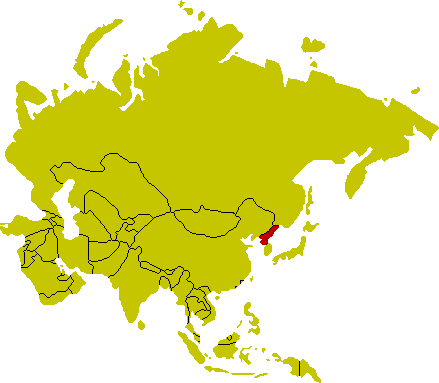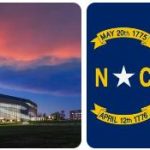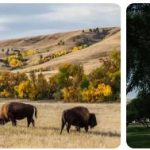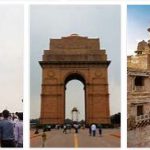
North Korea Guide
North Korea – country information
| Country name | North Korea |
| Official name | Democratic People’s Republic of Korea |
| Capital | Pyongyang |
| Continent | Asia |
| Area | 120,538 km2 |
| Population | 24,895,000 (2013) |
| Foundation of a state | 8/15/1945 |
| The highest mountains | Pektusan 2744 m |
| Longest rivers | Amnokgang (Jalu) 790 km |
| State system | a republic with a one-party system of government |
| The biggest cities | Pyongyang (capital) 3,250,000, Hamhung 950,000, Chongjin 875,000 |
| Official language | Korean |
| Ethnicity/National Composition | Korean 99.8%, Chinese 0.2% |
| Religious affiliation | atheists 70%, Chondogyo 15%, traditional faith 13%, Buddhists 1.5%, Christians 0.5% |
| Currency | 1 won (W) = 100 won |
| Average life expectancy of the population | 71.65 years (2006) |
| Structure of GDP | agriculture and fishing 32%, mining and industry 30%, construction 8%, services 30% |
North Korea – Neighboring States
| State | Capital | Area | Population |
| China | Peking | 9,640,820 km2 | 1,363,350,000 |
| South Korea | Seoul | 99,538 km2 | 50,219,669 |
| Russia | Moscow | 17,098,200 km2 | 143,700,000 |
Country overview
According to Abbreviationfinder, communist North Korea occupies the northern half of the Korean Peninsula in northeastern Asia. More than a third of the nation, which was divided after World War II, lives here.
Country data
Location: Osatasia
Time zone: CET + 7.5 (during summer time: CET + 6.5)
Total area: 120,538 km²
Land area: 120,408 km²
Water area: 130 km²
Length of the state border: 1,672 km
Bordering countries:
China: 1,416 km
Russian Federation: 18 km
South Korea: 238 km
Coastline: 2,495 km
Capital: Pyongyang
Provinces: 11
Chagang-do, Hamgyong-bukto, Hamgyong-namdo, Hwanghae-bukto, Hwanghae-namdo, Kangwon-do, Nason-si, P’yongan-bukto, P’yongan-namdo, P’yongyang-si, Yanggang -do
Electric current: 110, 220 V / 60 Hz
Telephone code: 00 850 (Source: Allcitycodes)
Highest point: Paektu 2,744 m
Population
Population: approx. 25 million residents (Countryaah, 2021)
Population growth: 0.5% per year
Population density (residents per km²): 207
Life expectancy: 66 (male), 74 (female)
Official language: Korean
Religions: Buddhists, Christians, others
Climate
The climate in North Korea is almost the same as in Central Europe.
The summer months are warm and humid. Most of the rain falls at this time of year, with temperatures around 25 ° C.

In winter it is dry and there is occasional snow at temperatures down to -10 ° C.
Currency / finance
Currency unit: Won (KPW)
Division: 1 won = 100 chon
ATMs: are not available.
International credit cards: Very rarely accepted in some tourist hotels.
Regulations: Foreign currencies can be imported and exported in unlimited amounts. There is an obligation to declare.
The import and export of the local currency is prohibited.
All purchase receipts should be retained until departure.
Customs regulations
The following may be carried duty-free:
- 200 cigarettes or 250 g tobacco
- 1 liter of alcoholic beverages
(Information applies to people aged 18 and over)
Tourists and people in transit can bring items of personal use with them duty-free.
Since there are seldom goods to buy, you should bring all the items you need with you when you arrive.
Expensive electrical appliances (laptops, cameras, TV sets, etc.) must be declared upon entry.
Travel advice
All tourists are constantly accompanied by an interpreter or control person.
Spontaneous individual excursions are not possible.
The population is prohibited from uncontrolled contact with local residents under threat of punishment.
Power and water failures and deficiencies in the supply of goods must always be expected.
Economy
North Korea’s tightly centralized planned economy is geared towards self-sufficiency. All major major industries are in state hands and are controlled by the country’s leadership elite.
Although a large part of the population works in agriculture, the yields are not sufficient for self-sufficiency.
Due to the abundant natural resources, a strong industry in the mining and processing area could develop.
Industries: mining, chemistry, power generation, food production, mechanical engineering, metal processing, military industry, textiles
Natural resources: lead, iron ore, gold, graphite, coal, copper, magnesium, molybdenum, salt, hydropower, tungsten, zinc
Land use:
- Land: 14%
- Grain cultivation: 2%
- Pasture area: 0%
- Forests: 61%
- other: 23%





